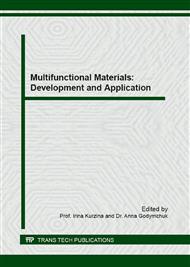[1]
J. -Y. Sohn., H. -J. Sung, J. -M. Song, J. Shin, Y. -C. Nho, Radiation-grafted protonexchange membranes based onco-grafting from binary monomer mixtures intopoly(ethylene-tetrafluoroetthylen, Radiation Physics and Chem. 81 (2012) 923-926.
DOI: 10.1016/j.radphyschem.2012.02.019
Google Scholar
[2]
S.M.J. Zaidi, T. Matsuura, Polymer membranes for fuel cells, Springer Science+Business Media, USA, (2009).
Google Scholar
[3]
V. Ya. Kabanov, V.I. Feldman, B.G. Ershov, Radiation chemistry of polymers, High Energy Chem. 43 (1) (2009) 1-8.
Google Scholar
[4]
M.M. Nasef, H. Saidi, K.Z.M. Dahlan, Radiation grafted poly(vinylidene fluoride)-graftpolystyrene sulfonic acid membranes for fuel cells: structure-property relationships, Chin. J. Polymer Sci. 28 (5) (2010) 761-770.
DOI: 10.1007/s10118-010-9138-2
Google Scholar
[5]
S.W. Lee, Yu. Bondar, D.H. Han, Synthesis of polypropylene fabric with sulfonate groups, Radiation Physics and Chem. 77 (4) (2008) 503-510.
DOI: 10.1016/j.radphyschem.2007.09.012
Google Scholar
[6]
L. Yu. Novoselova, E.E. Sirotkina, E.V. Sergeeva, Preparation and study of properties of sulfonic acid ion exchangers based on polypropylene fibrous material, Rus. J. Appl. Chem. 79 (3) (2006) 372-376.
DOI: 10.1134/s1070427206030074
Google Scholar
[7]
A. Bhattacharya, B.N. Misra, Grafting: a versatile means to modify polymers: techniques, factors and applications, Progress polym sci Vol. 29, No. 8, (2004) 767-814.
DOI: 10.1016/j.progpolymsci.2004.05.002
Google Scholar
[8]
L. Yu. Novoselova, E.E. Sirotkina, Polyolefinic fibrous ion-exchange materials: Properties and applications, Chem. Sustainable Develop. 14 (3) (2006) 199-213.
Google Scholar
[9]
T.R. Dargaville, G.A. George, D.J.T. Hill, A.K. Whittaker, High energy radiation grafting of fluoropolymers, Progress polym sci 28 (9) (2003) 1355-1376.
DOI: 10.1016/s0079-6700(03)00047-9
Google Scholar
[10]
T. Sata, Exchange Membranes: Preparation, Characterization, Modification and Application, Springer, (2004).
Google Scholar
[11]
A. Vahdat, H. Bahrami, N. Ansari, F. Ziaie, Radiation grafting of styrene onto polypropylene fibres by a 10 MeV electron beam, Radiation physics chemistry 76 (5) (2007) 787-793.
DOI: 10.1016/j.radphyschem.2006.05.009
Google Scholar
[12]
E.A. Cho, U.S. Jeon, H.A. Ha, S.A. Hong, I.H. Oh, Characteristics of composite bipolar plates for polymer electrolyte membrane fuel cells, J. Power Sources. 125 (2004) 178-182.
DOI: 10.1016/j.jpowsour.2003.08.039
Google Scholar
[13]
S.A. Sherif, F. Barbir, N. Veziroglu, Wind energy and the hydrogen economy – review of the technology, Sol Energy. 78 (2005) 647–60.
DOI: 10.1016/j.solener.2005.01.002
Google Scholar
[14]
Y. Woo, S.Y. Oh, Y.S. Kang, B. Jung, Synthesis and characterization of sulfonated polyimide membranes for direct methanol fuel cell, J. Membrane Sci. 220 (2003) 31-45.
DOI: 10.1016/s0376-7388(03)00185-6
Google Scholar
[15]
B. Soresi, E. Quartarone, P. Mustarelli, A. Magistris, G. Chiodelli, PVDF and P(VDF-HFP)-based proton exchange membranes, Solid State Ionics. 166 (2004) 383-389.
DOI: 10.1016/j.ssi.2003.11.027
Google Scholar
[16]
C. Schmidt, G. Schmidt-Naake, Proton conducting membranes obtained by doping radiation-grafted basic membrane matrices with phosphoric acid, Macromolecular Mater. Eng. 292 (2007) 1164-1175.
DOI: 10.1002/mame.200700188
Google Scholar
[17]
M. M. Nasef, H. Saidi, K.Z.M. Dahlan, Single-step radiation induced grafting for preparation of proton exchange membranes for fuel cell, J. Membrane Sci. 339 (2009) 115-119.
DOI: 10.1016/j.memsci.2009.04.037
Google Scholar
[18]
V.M. Golovkov, V.V. Sokhoreva, T. I. Sigfusson, Formation of Chemically Resistant Tract Membranes, Petrol. Chem. 52 (7) (2012) 462-464.
DOI: 10.1134/s0965544112070055
Google Scholar
[19]
V.V. Sokhoreva, V.M. Golovkov, N.A. Dubrova, D.F. Sidko, Laws of Radiation Grafting of Styrene to PVDF Films and Characterization of the Grafted Polymer, Adv. Mater. Res. 1084 (2015) 42-45.
DOI: 10.4028/www.scientific.net/amr.1084.42
Google Scholar
[20]
V.M. Golovkov, V. V. Sokhoreva, Yu.I. Tyurin, T.I. Sigfusson, Polutschenije of a polymeric electrolytic membrane for a combustion cell a method of radiation-chemical processing of a film of PVDF, Higher Education Institutions. Physics 54 (11/3) (2013).
Google Scholar


